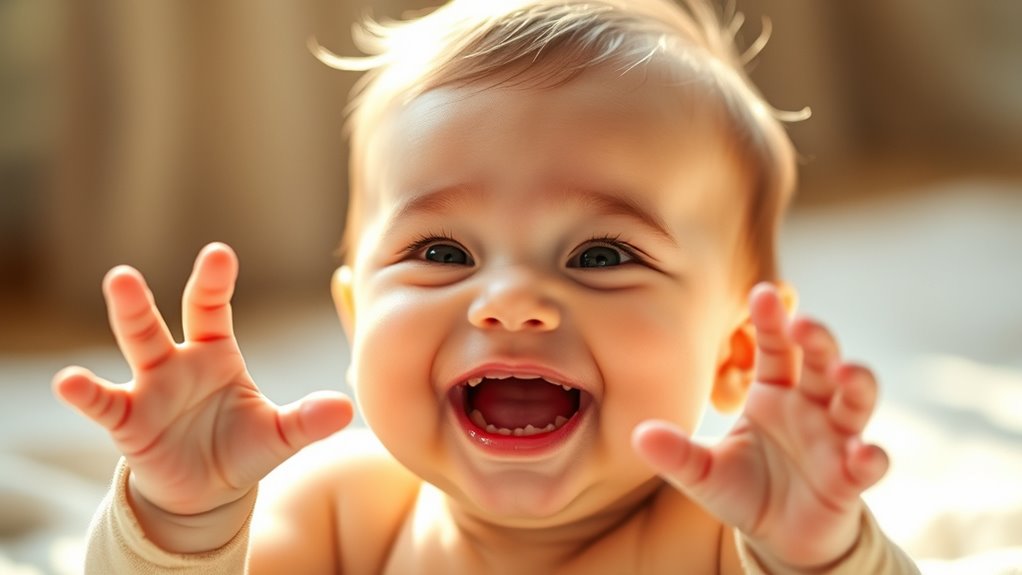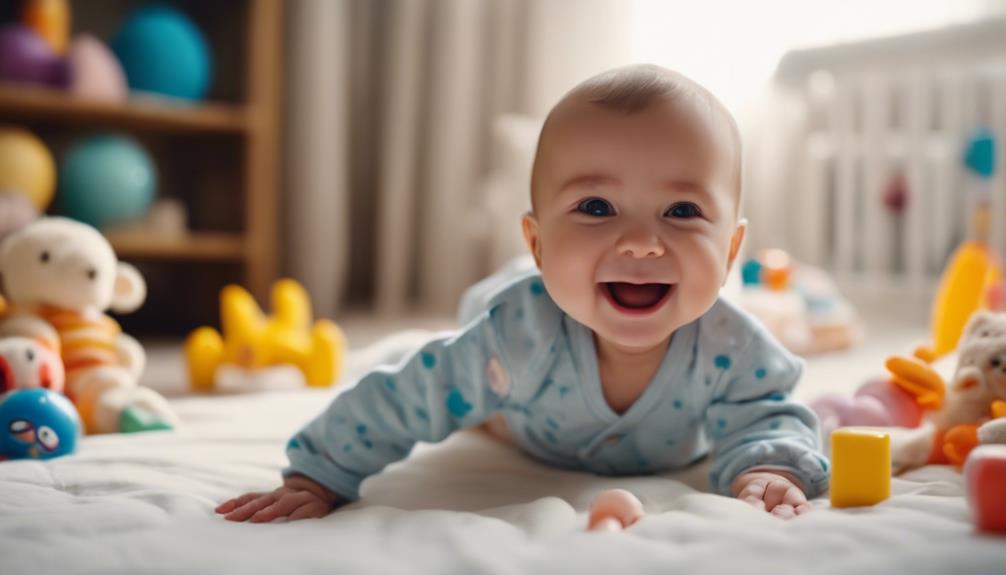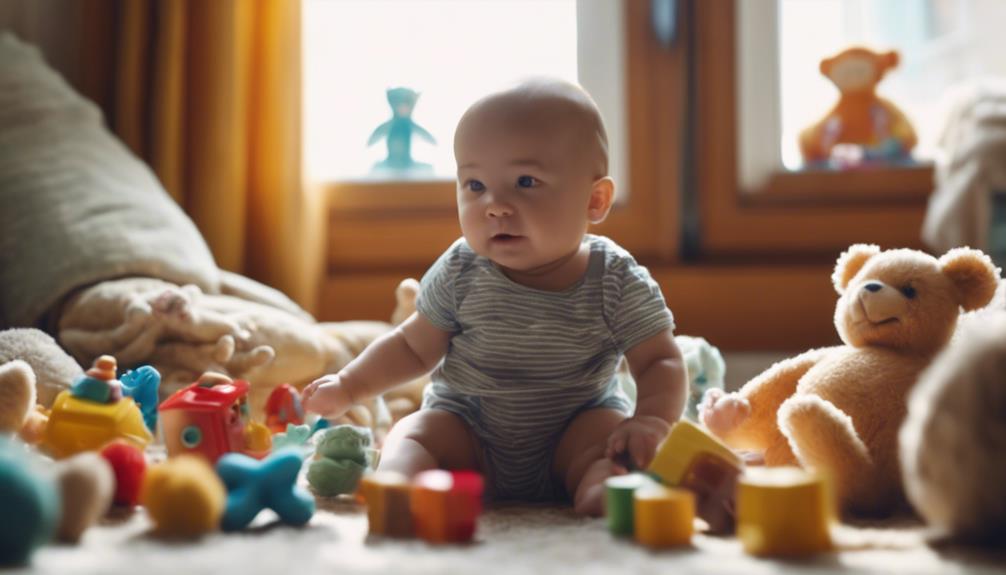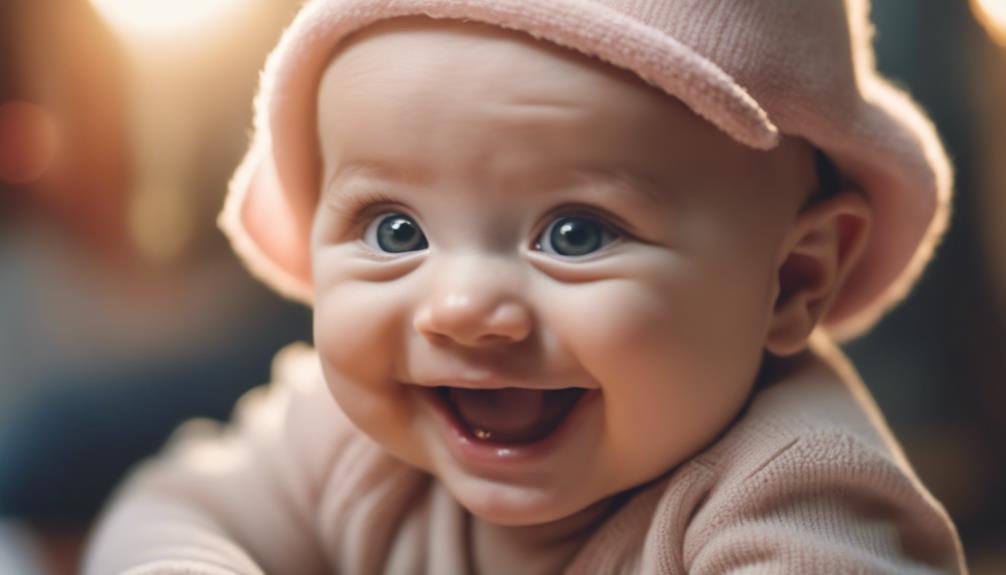To recognize a happy baby, look for genuine smiles that involve eye crinkling and spontaneous laughter, especially during play or exploration. Notice their curiosity when they reach or squeal with delight, and observe relaxed body language with soft, open faces and calm movements. Consistent sleep and feeding routines also indicate contentment. Engaging with your baby’s social cues, like eye contact and responsive gestures, helps you understand their true emotional state. Keep discovering these cues to better connect with your little one.
Key Takeaways
- Genuine smiles often involve eye crinkling and spontaneous reactions during positive interactions.
- Playful exploration, giggles, and curiosity indicate happiness and a sense of security.
- Relaxed body language, soft facial expressions, and steady breathing show contentment.
- Consistent sleep and feeding routines reflect emotional stability and well-being.
- Engaged eye contact and responsive vocalizations strengthen social bonds and emotional health.
Recognizing Genuine Smiles and Laughter

Genuine smiles and laughter are clear signs that your baby is truly happy. You’ll notice these authentic expressions often appear when your baby reaches developmental milestones, like mastering new skills or exploring their environment. However, teething discomfort can sometimes mask their happiness, causing fussiness or less frequent smiles. Still, authentic smiles usually involve the eyes crinkling and a spontaneous, heartfelt reaction that reflects genuine joy. Pay attention to the context—if your baby is engaged, playful, or interacting positively, their smiles are likely sincere. Laughter that comes freely and consistently during playful moments signals contentment and emotional well-being. Recognizing these cues helps you understand your baby’s happiness beyond just their physical comfort. Additionally, observing your baby’s emotional cues can provide further insight into their overall mood and well-being. Understanding how visual perception affects their responses can also influence how they interpret different environments and stimuli.
Noticing Playful and Curious Behavior
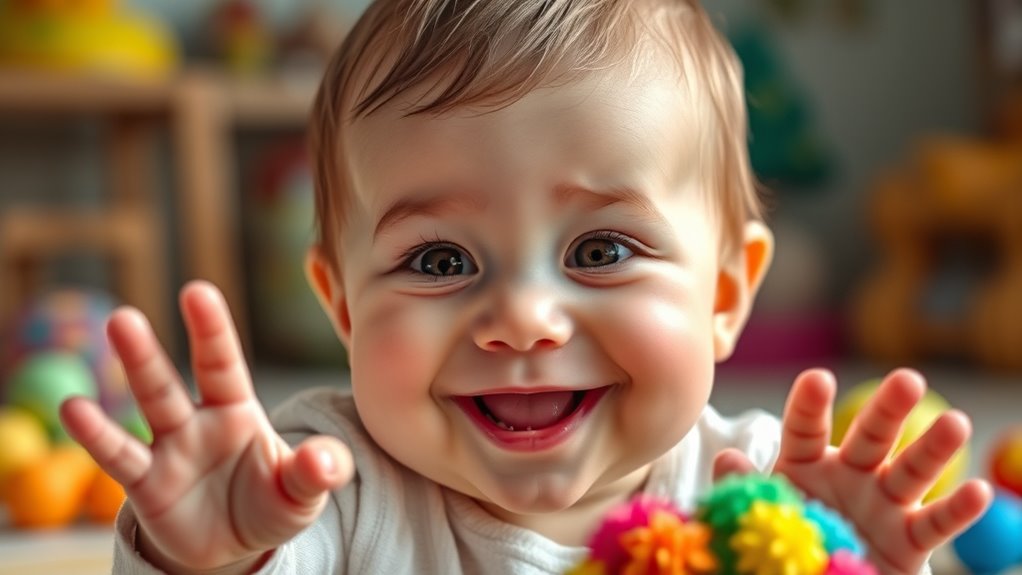
When your baby starts exploring their surroundings with curiosity and playful energy, it’s a strong sign they’re feeling happy and secure. During tummy time, you might notice them lifting their head, reaching for toys, or turning toward sounds they hear. They might squeal or giggle when exploring new sounds or objects, showing enthusiasm for discovery. Curious babies often investigate their environment with wide eyes and a keen interest, sometimes trying to grasp or mouth objects. These behaviors indicate they’re comfortable, engaged, and enjoying their experiences. Playful exploration and exploring sounds are key signs that your baby feels safe and happy. Recognizing this curiosity helps you understand their emotional state and encourages further positive interactions. Additionally, myelination supports rapid neural development that underpins these explorations and reactions. This process enhances neural connections, enabling more complex behaviors and responses as your baby grows. Furthermore, a supportive environment fosters continued emotional development, reinforcing their sense of security and happiness. Engaging in responsive and stimulating interactions can further promote their neural development and emotional well-being.
Observing Relaxed and Calm Body Language
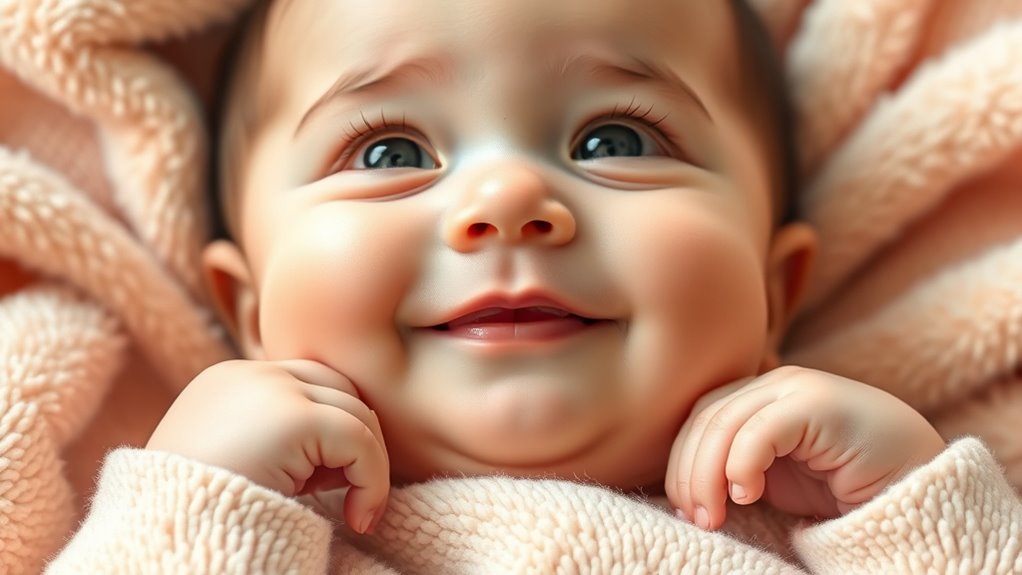
Noticing your baby’s relaxed and calm body language is a clear sign they feel happy and secure. When your baby is comfortable, their muscles soften, and their movements become gentle. This calmness supports your growing parenting confidence and indicates they’re reaching key developmental milestones. Look for signs like a loosely open mouth, relaxed limbs, and steady breathing. These cues show your baby feels safe and content. Use this awareness to strengthen your bond and respond with reassurance. Here’s a quick guide:
| Calm Baby Cues | Interpretation |
|---|---|
| Loose limbs, relaxed posture | Feeling safe and happy |
| Soft, open face | Contentment, comfort |
| Steady breathing | Relaxed state |
| Mild movements | Calm alertness |
Recognizing these signs helps you better understand your baby’s emotional well-being. Being attentive to emotional cues can further improve your responsiveness and foster a secure attachment. Additionally, understanding AI security principles can help you stay informed about advancements that support safe and trustworthy AI development. Moreover, understanding sleep and dreams can help you create a calming environment that promotes your baby’s overall happiness and well-being. Observing these body language signals also encourages you to become more attuned to your baby’s needs, which is vital for nurturing a positive emotional connection.
Identifying Consistent Sleep and Feeding Patterns
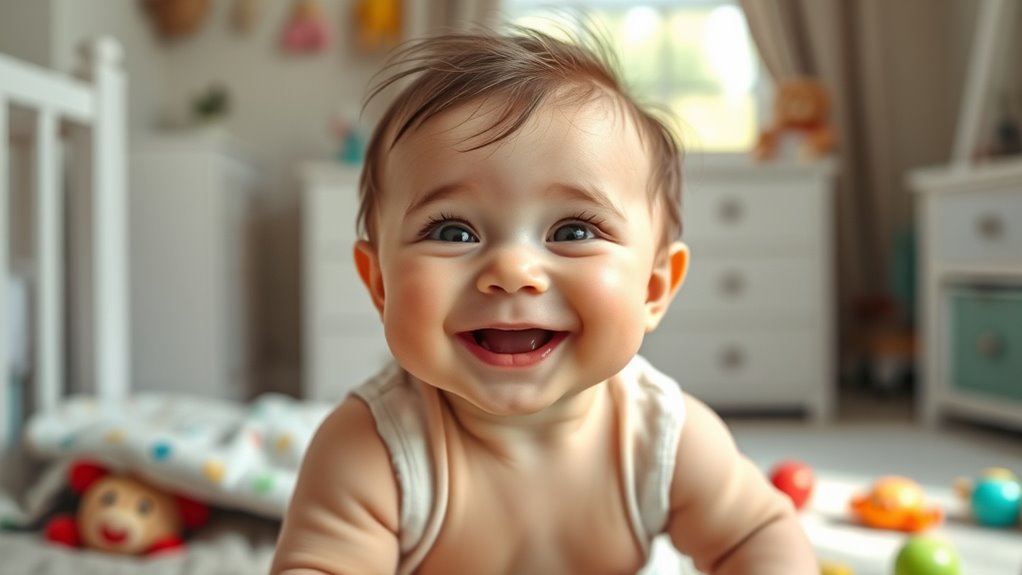
Establishing consistent sleep and feeding patterns is essential for your baby’s well-being and development. When your feeding routines and sleep consistency are predictable, your baby feels secure and relaxed. Look for signs such as:
- Regular feeding times each day
- Short, predictable naps and nighttime sleep
- Waking up hungry at similar times daily
- Reduced fussiness between feedings
- Falling asleep easily after feedings
These patterns indicate your baby’s needs are being met and help create a sense of stability. When your baby’s sleep and feeding routines are consistent, it promotes emotional security and supports healthy growth. By observing these cues, you can adjust routines to better suit your baby’s natural rhythms, fostering happiness and contentment. Consistent routines also help your baby develop healthy sleep habits, which are crucial for their overall well-being. Additionally, maintaining regular feeding and sleeping patterns can influence your baby’s tuning to their natural rhythms, making it easier to meet their needs effectively.
Responding to Your Baby’s Social Interactions
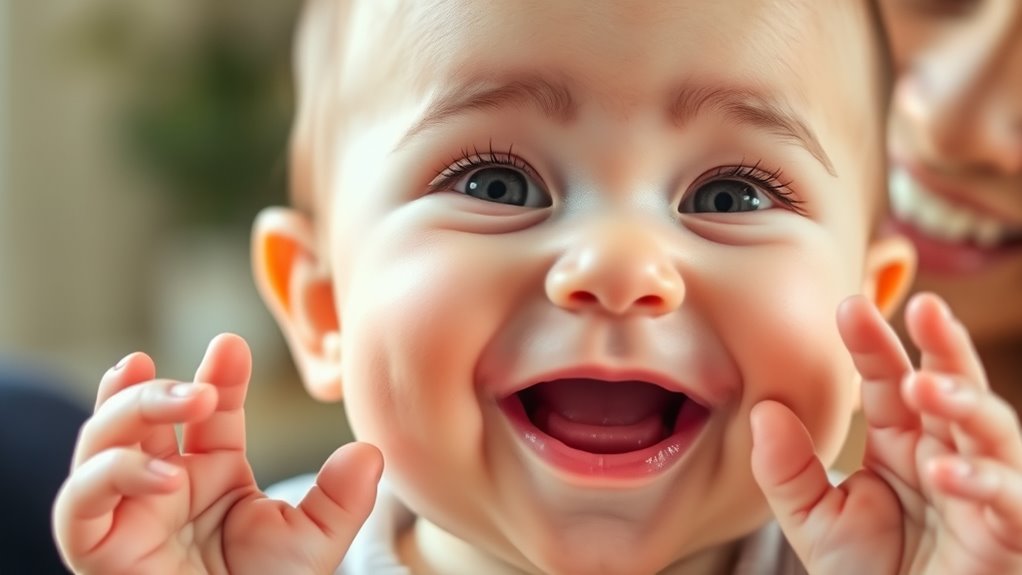
Responding promptly and warmly to your baby’s social interactions encourages their developing communication skills and builds trust. When your baby makes eye contact, use it as an opportunity to bond through eye contact, showing you’re engaged and attentive. Respond to their vocalizations with smiles, gentle sounds, or words, reinforcing that their attempts to communicate are valued. This back-and-forth interaction helps your baby understand social cues and encourages them to express themselves more confidently. By consistently acknowledging their social efforts, you foster a sense of security and happiness. Incorporating advanced segmentation techniques into your responses allows you to tailor your interactions based on your baby’s unique cues, further enhancing their emotional development. Paying attention to emotional cues can also help you become more attuned to your baby’s individual temperament and needs. Recognizing and responding to emotional triggers can strengthen your bond and support their overall emotional well-being. Remember, your attentive responses nurture their emotional development and strengthen your connection, laying the foundation for healthy, positive relationships in the future.
Frequently Asked Questions
How Can I Tell if My Baby’S Fussiness Is Due to Discomfort?
If your baby’s fussiness seems ongoing, check for signs of discomfort. Teething discomfort often causes drooling, biting, or gum swelling, while diaper rash results in redness and irritation. You might notice your baby pulling at their ears or clenching their fists, indicating they’re uncomfortable. Pay attention to their cues, and if fussiness persists, consult your pediatrician to rule out other issues and find relief for your little one.
What Are Subtle Signs of a Happy Baby Beyond Smiles?
Imagine the quiet symphony of a happy baby. Beyond smiles, look for gentle eye contact that feels like a secret shared just with you. Notice their relaxed body language and soft, contented sounds. A gentle touch can turn a fuss into calmness, showing comfort and trust. These subtle signs reveal your baby’s happiness, like whispers of joy that only a loving parent can understand and cherish.
How Do I Differentiate Between Tired and Overstimulated Behaviors?
To tell if your baby is tired or overstimulated, watch for baby sleep cues like yawning, rubbing eyes, or fussiness, which indicate tiredness. Overstimulation signs include turning away, arching back, or becoming irritable. If your baby shows these cues, gently soothe them to help settle their emotions. Recognizing these signals helps you respond appropriately, ensuring your little one feels safe and comfortable.
When Should I Be Concerned About My Baby’S Emotional Development?
Like a delicate flower, your baby’s emotional development blooms gradually. You should be concerned if you notice delays in reaching emotional milestones, such as difficulty soothing or limited eye contact, which could signal developmental delays. Trust your instincts and consult your pediatrician if you’re worried. Early intervention can make a difference, ensuring your baby’s emotional growth stays on track, fostering a healthy, happy future.
How Can I Encourage Positive Social Interactions in My Baby?
To encourage positive social interactions, engage your baby with playful gestures like smiling, waving, or gentle tickling, which foster connection and comfort. Sing songs and play peekaboo to boost social milestones such as eye contact and imitation. Respond warmly to your baby’s cues, creating a safe environment that promotes trust. Your active involvement helps your baby develop essential social skills, laying a foundation for healthy relationships later in life.
Conclusion
By paying attention to your baby’s genuine smiles, curious play, relaxed body language, and consistent routines, you can truly understand their emotional well-being. Responding to their social cues strengthens your bond and promotes happiness. Did you know that babies who feel emotionally secure are more likely to develop healthy relationships later in life? Trust your instincts and cherish these moments—they’re the foundation of a happy, confident little one.

